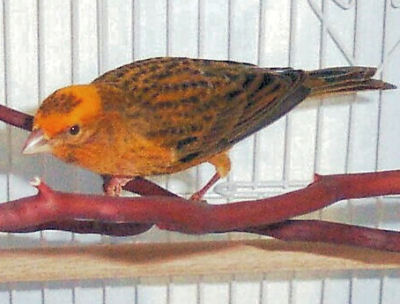
Named for its unique markings, the striking Lizard Canary is one of the oldest canary breeds that has not been changed since it was first developed!
Even though this pretty little bird is one of the oldest varieties it has had a rather rocky history. They almost became extinct in the early 1900’s. With two world wars and disease epidemics, the Lizard Canary was reduced to only a couple dozen breeding pairs by the mid 1940’s. With the help of the Lizard Canary Association of Great Britain and a closely monitored “come-back” breeding program, today this canary thrives and is one of most popular Type canaries available.
A “type canary”, is bred for physical trait or shape rather than color or song. The Lizard Canary is bred for the spangled effect of its feathers, a result of a gene that restricts the tendency of melanin in the plumage. This spangling effect diminishes with each annual molt however, so a Lizard is best shown in its first year.
For more information about the care of Canaries see:
Guide to a Happy, Healthy Canary
- Kingdom: Animalia
- Phylum: Actiniform
- Class: Elasmobranchii
- Order: Passeriformes
- Family: Fringillidae
- Genus: Serinus
- Species: canaria
Scientific Name:
Distribution:
The Lizard Canary originated in France in the 1700’s. Though never extremely popular in Europe they were in no danger of disappearing, until the 1900’s. Severely threatened with the advent of two world wars along with disease epidemics, their numbers were reduced to about only 40 birds. In 1945 the Lizard Canary Association of Great Britain was formed with the intent of re-establishing these birds, serious breeders selling birds only to other serious breeders. Today the Lizard Canary thrives and is one of most popular “type canaries” available.
Description:
The Lizard Canary reaches about 5 1/2 inches (14 cm) in length. The characteristic scale pattern of the Lizard, known as ‘spangling, is the most important aspect of these birds for show. Spangling consists of a series of black crescent-shaped spots running in even uniform rows down their backs.
Besides their characteristic feather pattern, the Lizard Canary is distinguished by a yellow ‘cap’ of color on its head. The cap is also very important for show. A nice oval full-cap starts at the beak and extends to the base of the head. A broken-cap is irregularly interspersed with dark feathers and if there is a predominance of dark feathers it is referred to as a non-cap.
These birds are available with either a ground color of yellow known as a ‘gold’, a ground of buff known as a ‘silver’, or with a red ground.
Care and feeding:
Canaries like wide open spaces so provide a roomy cage. Provide a cage with vertical bars and small perches of different size for foot exercise. Have at least 1 perch set high in the cage for the canary to roost (sleep). The cage should be placed high, so the canary can look down on us so to speak.
Canaries eat mainly canary seed and rape seed. Vitamin coated canary seed mixes are readily available at a pet store. Greens are also enjoyed and can be offered daily along with a little calcium in the form of a cuttlebone.
They do like to bath, so should be offered a bird bath. Cage cleaning and toe nail trimming is about all the maintenance canaries need.
See About Canaries: Housing and About Canaries: Care and Feeding for more information.
Social Behaviors:
They are good-natured social creatures that do well when kept in cages or in aviaries. They are timid birds though and should not be housed with parakeets, lovebirds, or other hookbills that tend to be more aggressive birds by nature.
Male canaries should be kept in a cage by themselves to ensure quality singing. Males can be territorial and pairing up with two male canaries in a cage can cause fights. In a spacious aviary canaries can generally be housed with other canaries, finches, and other hardbills.
Activities:
Canaries do not require toys, mirrors or any other form of entertainment, a swing is all they need to keep themselves occupied. Most of the time, canaries are simply enjoyed for their beauty and singing. However, some canaries are allowed out of their cage to perch or are show canaries and therefore require taming or training.
See About Canaries: Handling/Training for information on taming and training.
Breeding/Reproduction:
The Lizard Canary is a very free breeder. Most canaries breed easily and readily if provided with quality food, lighting, secure surroundings, and conditioning. Breeding season for most canaries is usually from December to April. They are best bred in breeding cages.They lay their eggs in a nest. The female will lay 3 to 6 eggs, one per day. It is best to allow a hen to have only two clutches. Breeders will normally breed a full-cap Lizard Canary to a broken-cap.
See About Canaries: Breeding/Reproduction for more information on breeding.
Potential Problems:
These birds are hardy and healthy if provided with a good environment and a good diet. Avoid an environment that is wet, cool, and drafty.
See About Canaries: Potential Problems for information on health.
Availability:
Lizard Canaries are fairly available with prices ranging between $50 to $100 US. They are most often available through breeders, but may also occasionally be found through bird shows, bird clubs, and on the internet.
Featured Image Credit: Fernando Zamora Vega, Shutterstock
